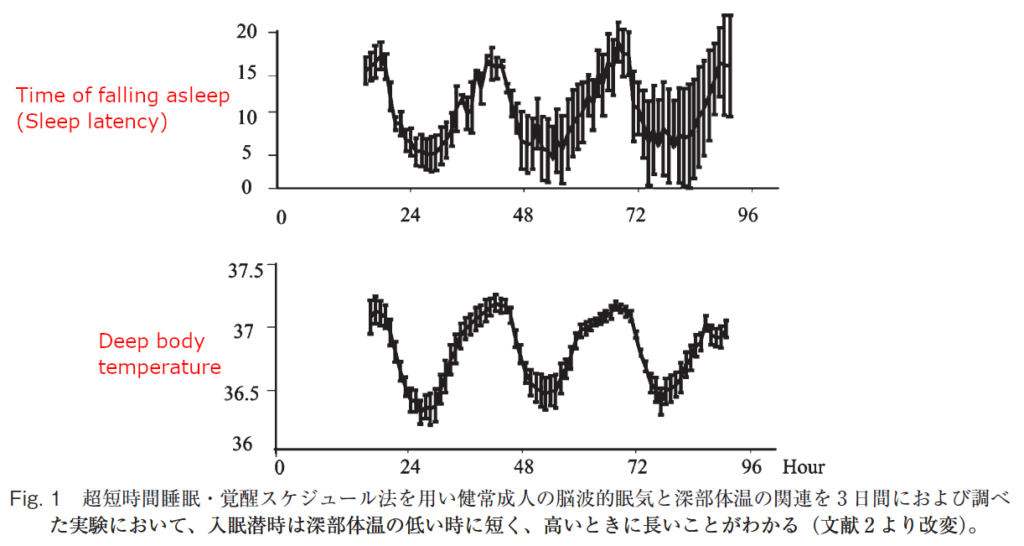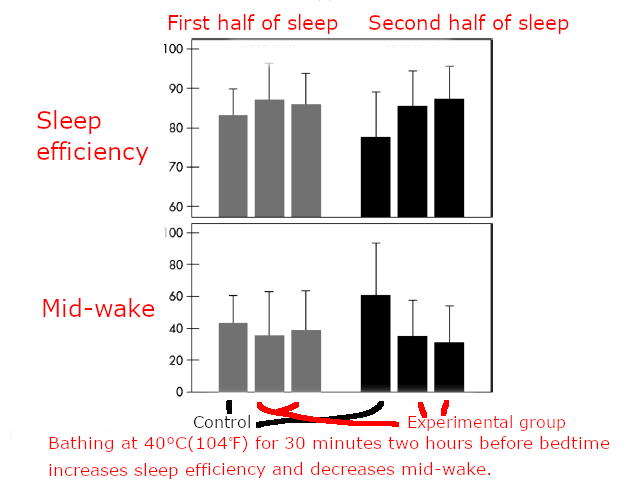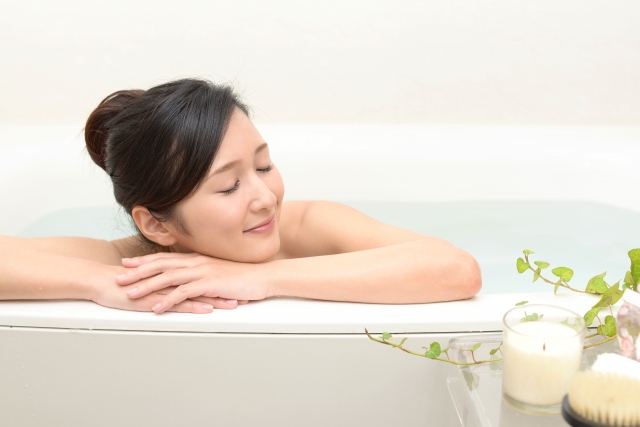Just changing the way you bathe can dramatically help you fall asleep more easily.
Bathe 2 hours before you want to go to bed, and bathe at 40°C(104℉) for 30 minutes. However, the bath should warm the body to the core, so if you feel faint, shorten the time. Bathing temporarily raises the body temperature, and the subsequent drop in deep body temperature reduces the difference between the skin temperature and the body temperature, making it easier to sleep.
The research paper ヒトの体温調節と睡眠 is cited and referred to in this report.
Deep body temperature tends to be higher during the day and lower at night in humans who are active during the day due to circadian rhythms.
When deep body temperature is high, enzymatic reactions in the body become more active and energy is produced. In other words, we can say that the body temperature is raised in order to be active.
Conversely, when deep body temperature is low, enzymatic reactions are suppressed, metabolism is lowered, and the whole body, including the brain, is in a resting state.
The figure below shows that the lower the deep body temperature at the time of falling asleep (sleep latency), the shorter the time it takes to fall asleep.

The fluctuations that occur in the 24-hour cycle of deep body temperature are controlled by heat dissipation from the skin. Sleep is induced when the deep body temperature falls due to heat dissipation. This is the reason why “babies warm hands and feet are a sign” that they want to sleep.
Following this finding, it has been reported that people who are cold and prone to cold hands and feet take longer to fall asleep. It can be interpreted that cold people with low peripheral skin temperatures are unable to dissipate heat and lower their deep body temperature, which interferes with the transition to sleep. The reason it is difficult to sleep when the temperature is high or the humidity is high is because it is difficult for heat to escape from the skin.
The research paper Sleeping with an Electric Blanket: Effects on Core Temperature, Sleep, and Melatonin in Young Adults is cited and referred to in this report.
Furthermore, the environmental temperature during sleep is closely related to the quantity and quality of sleep. It has been reported that keeping the temperature inside furniture at a high level during sleep, for example by using electric blankets, causes more awakenings in the middle of the night, which leads to unstable sleep. When heat dissipation is disturbed, deep body temperature is not lowered sufficiently, and sleep becomes unstable.
This close relationship between body temperature and sleep has led to the idea of ways to promote sleep by taking a bath or footbath before bedtime. It has been reported that bathing under the right conditions can improve sleep.
The research paper Cold feet and prolonged sleep-onset latency in vasospastic syndrome is cited and referred to in this report.
A study has investigated bathing to mid-chest at 40°C(104℉) for 30 minutes two hours before bedtime. The figure below shows a comparison between the previous (control) and a 30-minute 40°C bath up to mid-chest 2 hours before bedtime. The upper side of the figure shows sleep efficiency and the lower side shows mid-wake data. Sleep efficiency can be calculated by dividing the time spent asleep by the time spent lying on the bed. In other words, the shorter the time it takes to fall asleep, the higher the sleep efficiency. The time of mid-awakening is the time when you fell asleep but woke up in the middle of the sleep. The shorter the time of mid-awakening, the better, or you do not want to wake up in the middle of sleep. The figure shows that bathing under these conditions increases sleep efficiency. In other words, it was found to shorten the time it takes to fall asleep, and furthermore, to decrease the time of mid-awakening!

The research paper Passive body heating ameliorates sleep disturbances in patients with vascular dementia without circadian phase-shifting is cited and referred to in this report.
There is a report of an experiment in which 6 women with fibromyalgia were given a 36°C bath from 6 to 8 pm, 5 times a week for 3 weeks. Results showed that on the first day, REM sleep latency was shortened and deep sleep was increased; by the end of 15 sessions, waking time was reduced, sleep latency was shortened, REM sleep latency was shortened, sleep efficiency was increased, and deep sleep was increased. Furthermore, these effects persisted in a study conducted three weeks after the end of the experiment.
Some studies have also shown benefits from foot bathing. In a study of 18 female patients undergoing chemotherapy for gynecological tumors who were divided into two groups, one with nightly foot bathing and the other without, subjective sleep evaluations were conducted over a 6-month period.
These results suggest that bathing with a transient increase in skin temperature and deep body temperature may have stimulated the body temperature center and subsequently increased blood flow in skin peripheral blood vessels, resulting in an increase in heat dissipation and promoting sleep.
In addition, carbonic acid bath salts seem to have a vasodilating effect, which is believed to further enhance the effects of bathing.
I actually did it.
In fact, I even tried it with my 3 year old. We have a bath at 40 degrees Celsius and we go in together. I give him a toy to soak for a long time, but he can’t soak for very long. He don’t like it because it makes him run out of water.
The time spent in the bathtub is about 10 minutes. The time he stays in the bathtub up to his shoulders is about 3 minutes. It was about 30 minutes before he started taking off his clothes and getting out of the bath and getting dressed.
The children’s body was red, so I think his body was warm right after he got out of the bath.
I felt drowsy 1.5 to 2 hours after getting out of the bath. It was only 8:30pm at that time. However, two hours later, I felt that the child looked no different than usual.
Perhaps the child’s smaller body is not able to maintain a deep body temperature and dissipates heat more quickly. I thought that perhaps they felt sleepy about an hour after bathing.
I know it varies from person to person, but it worked for adults, so give it a try. Oh, and don’t forget to stay hydrated!



コメント